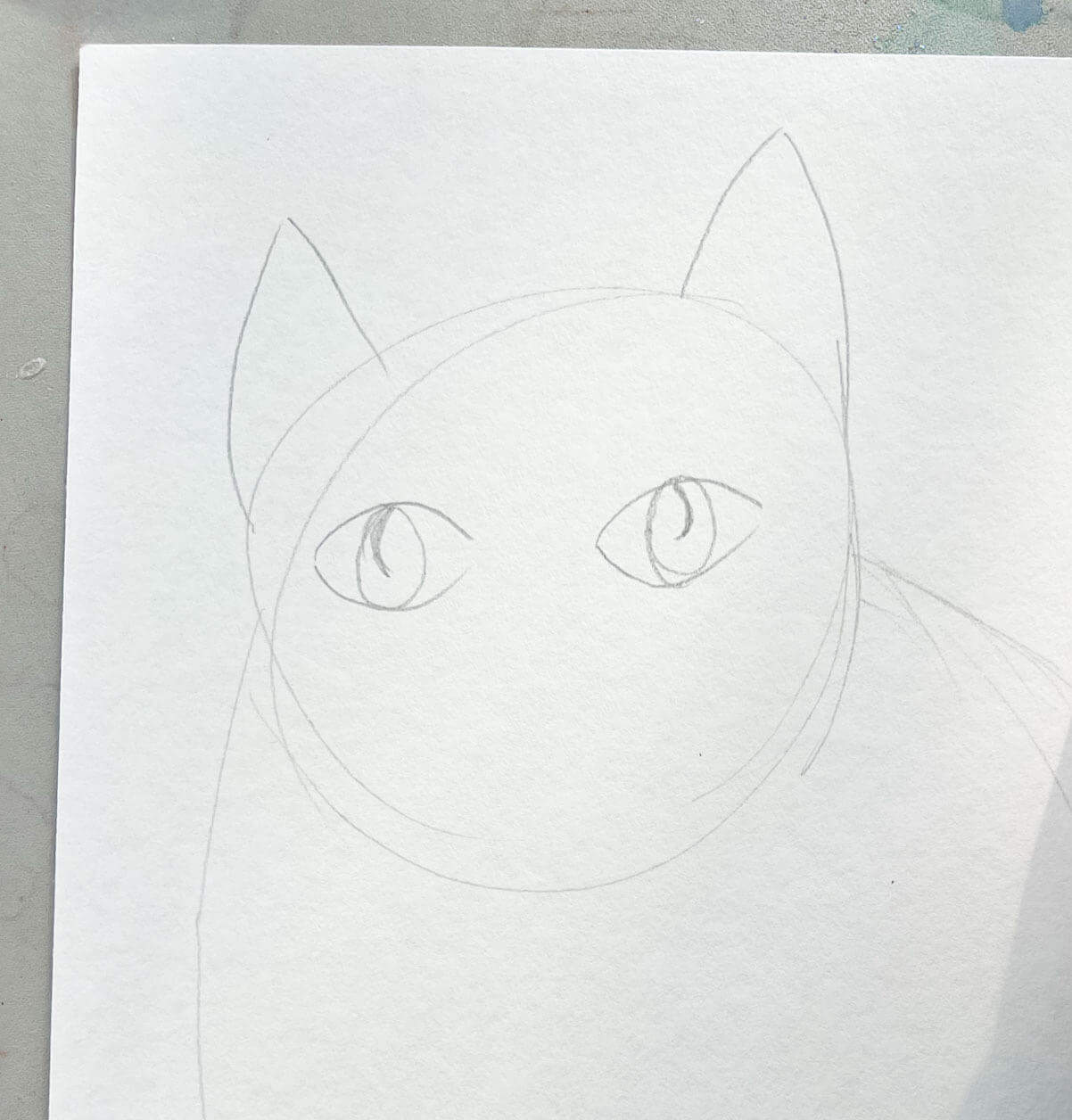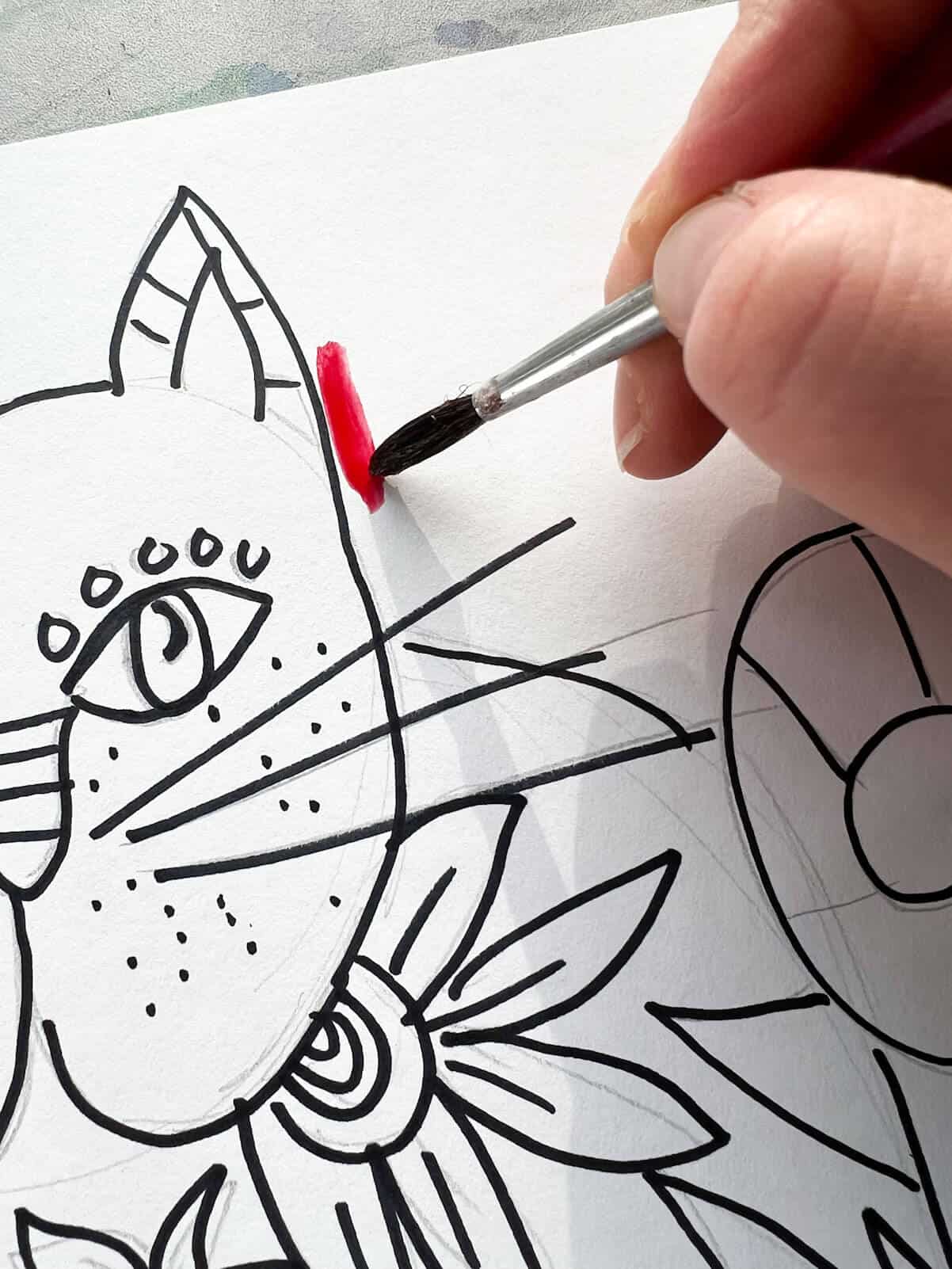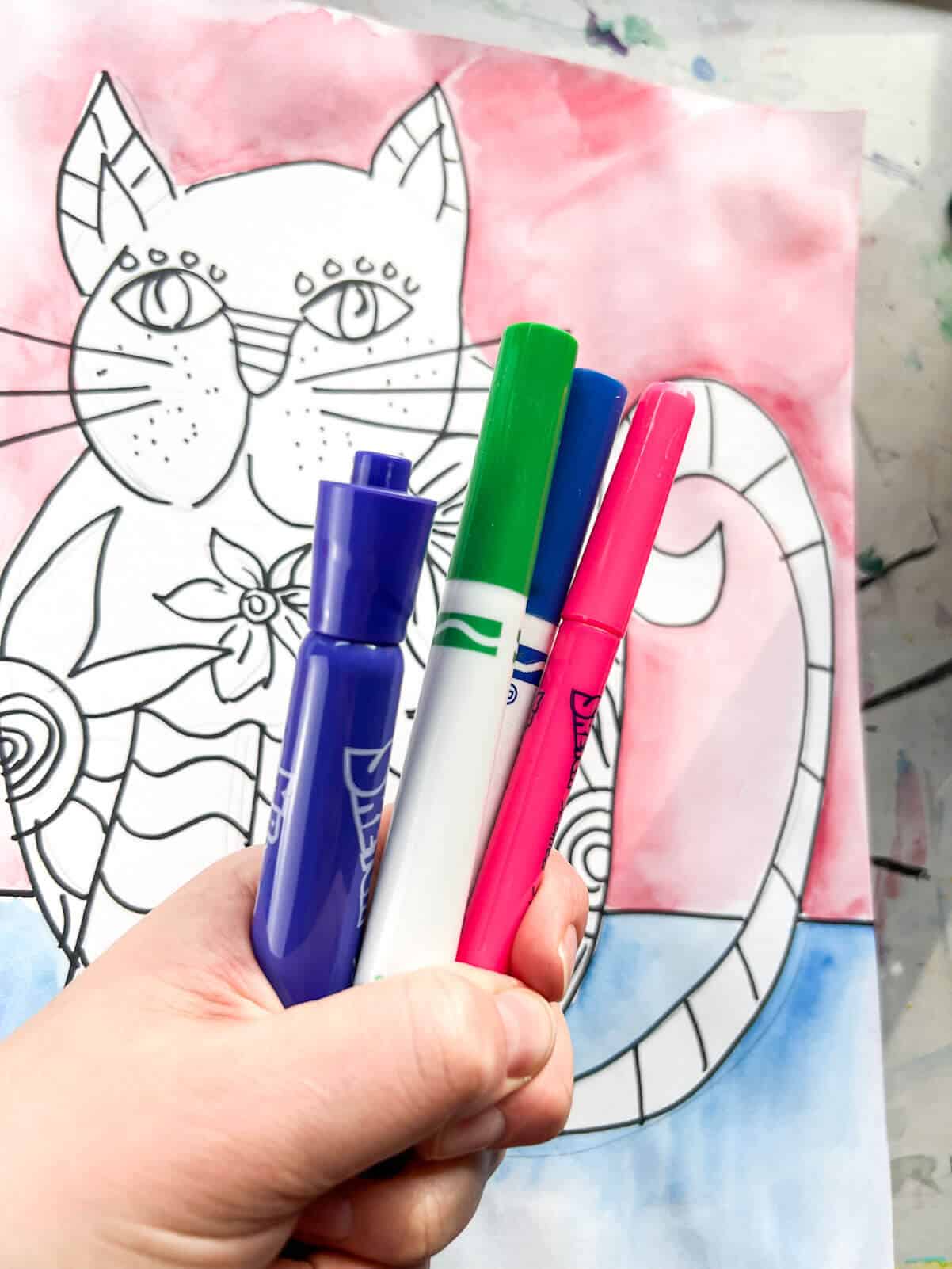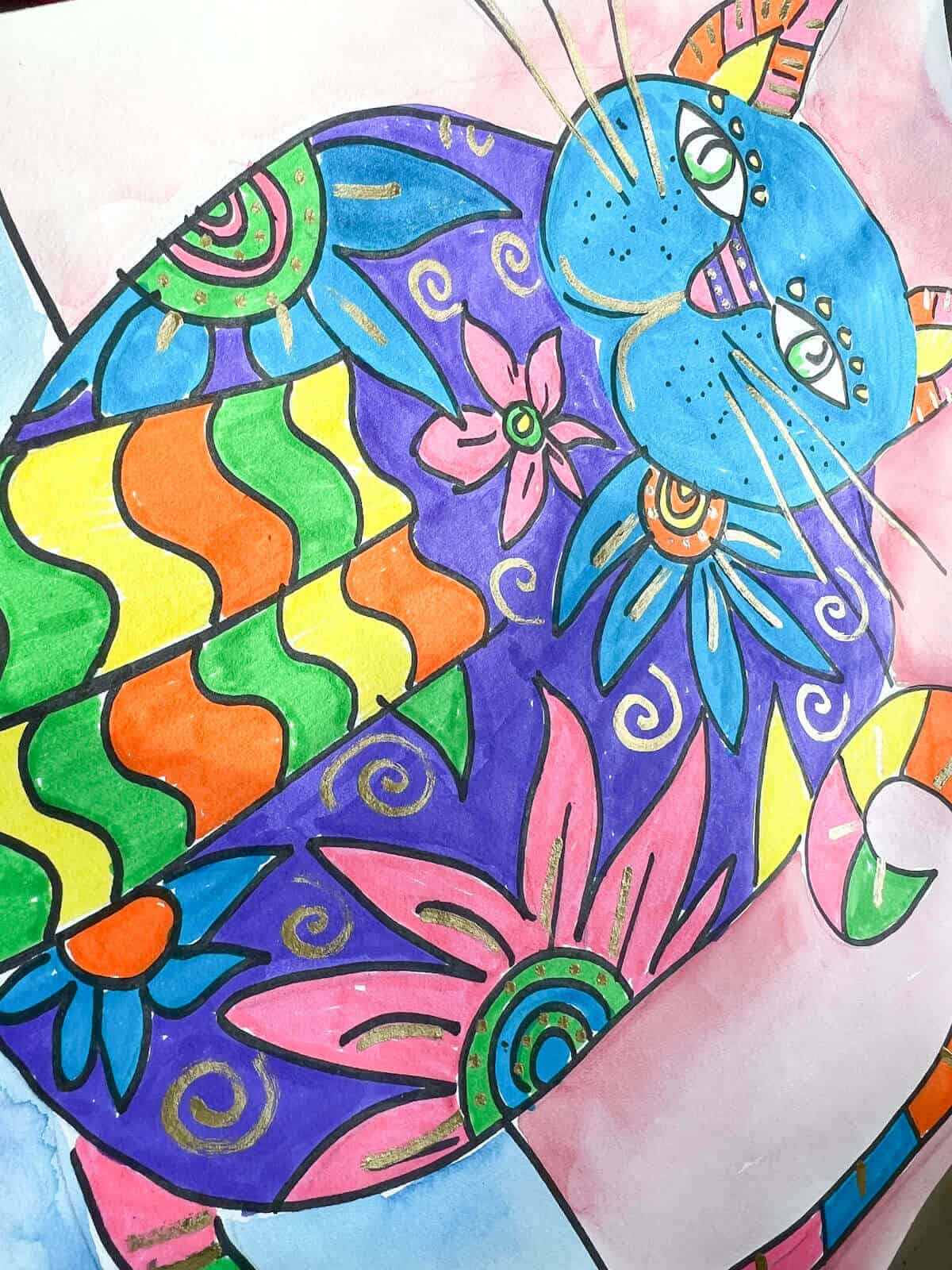Easy Cat Drawing Inspired By Laurel Burch
This easy cat drawing is inspired by the artist, Laurel Burch. Kids will showcase their personalities by creating their own unique patterned cat drawings.

Disclosure: We only recommend products we would use ourselves and all opinions expressed are our own. This post may contain affiliate links when clicked, we may earn a small commission at no additional cost to you. Read our full privacy policy.
What age is this project good for?
We love doing this project with 2nd graders. You can obviously modify it for any aged child. But we have found that second graders can really use their imaginations and have fun creating cats without worrying too much about it looking realistic.
Who is Laurel Burch?
According to Laurel Burch Studios, Laurel Burch was an artist that was born in 1945. In the 1960’s she began creating colorful and playful artworks in San Francisco, CA. Now her artworks can be found reproduced on all sorts of items from T-shirts to bags.
I actually scored this bag at a garage sale and the kids really do love seeing artwork and designs in person.

Laurel Burch did not have any formal training as an artist. Wikipedia notes that she always struggled with osteoporosis and had over 100 bone breaks in her lifetime. She still overcame her physical obstacles to share her creativity with the world.
By talking about her life with children, you are able to get them to see how people preserve and overcome tough times.
Not to mention her patterned cat and other animal artworks that are perfect to discuss with young children. They love how playful, colorful and creative these artworks are.
If you love this drawing project, then you may also want to check out how you can make slab clay cats as a different lesson.
Looking At Fantastic Feline Examples
When looking at Laurel Burch’s animal projects, you can get children to notice certain things about her work. You can use questions like the following to help:
- What kind of patterns do you see?
- Are these realistic cats?
- Why do you think she chose these colors?
- Are those normal cat eyes? How would you describe them?
- What other types of lines do you notice in her work?

Recommended Supplies
- 12” x 18” White Drawing Paper-you can do these smaller, but we like the scale of completing this on larger white paper.
- Variety Of Markers-Having skinny markers and chisel tip markers will provide children the opportunity to make a decision on which type will work best for their designs.
- Black Permanent Marker
- Pencil
- Gold or Silver Paint Marker-even 2nd graders can use these markers if you give them some guidelines and helpful tips that we list below.
Optional
- 2 colors of watercolor paint for the background
How To Draw A Simple Cat
Before You Begin
- Remind children that their projects are to look unique and that they do not have to look precisely like this guided drawing.
- You should “sketch light until you get right”
- Have fun creating your patterns and designs
Step 1: Draw A Circle Head
You want your cat to be large on the page. Draw a circular shape near the top of the page but leave enough room for the ears.

Step 2: Add A Large Body
When looking at Laurel Burch’s Fantastic Feline collection, kids will notice the large cats. I like to tell them they are drawing a “big, fat, cat”. This helps them draw a cat to scale. You can make the body more centered or show a little more of the side of the body.

Step 3: Add Ears
Add triangular shapes for ears.

Step 4: Draw Large Eyes
We are going to draw football-shaped eyes as Laurel Burch did.

However, any eye drawing would work. You can make these as detailed as you want.

Step 5: Draw A Simple Nose, Mouth and Whiskers
A simple “U” shape can work for the nose. An “anchor” mouth and whatever lines they want to use for whiskers.
Step 6: Add A Tail & Paws
Your tail can be curvy, straight or even zigzag. Add two legs in front of the cat. If the pencil lines overlap anywhere you will want to erase those extra lines.

If you don’t like the style of this cat sketch, then make sure you check out this other easy cat drawing that you could use as a starting point.
Step 7: Draw Horizon Line
Add a horizon line or table line behind the cat.
Step 8: Add Patterns and Details
With a pencil add details. I like to tell children, that if they want a baseball cat they can have a baseball cat. If you want a rainbow cat, draw it!

Like any kid art project, it is super important that kids feel their ideas matter and they can add their own touches.
Step 9: Outline With Permanent Marker
Some people may not agree with this, but for younger elementary students we like them to outline their drawings. This makes their hard work & details stand out. As they get older I try to work on teaching them how to have contrast without outlining.

Optional: Paint The Background With Watercolor Paint
If doing this in a class setting this is the perfect project to introduce watercolor paint. Let children pick any two colors to use. One color for the ground and one color for the sky. You need to limit the background colors because their cats will be so colorful and the focal point.

Step 10: Start Using Regular Markers
Be creative with the coloring.

The only place that you do not want to color is the whites of the eyes (or just say “eyeballs”). If kids color those in, then it is hard to see them due to a lack of contrast with all the patterns going on.

Tips For Marker Coloring With Children
- Give them different types of marker tips to work with. Discuss where they might want to use which kind (ex: skinny markers for small details)
- Show how to outline a shape first and then color them in.
- Encourage kids to color in one direction.
- You can also show them how to use a chisel tip to draw repeated lines to fill in a shape.
- If they are smudging their artwork, give them a piece of copy paper or paper towel (yea those school brown ones actually work well) to place under their drawing hand.

Step 11: Add Extra Details With A Paint Marker
Using a gold or silver paint marker can a few extra swirls or details. Before children can use a metallic paint marker, I make them take an oath. Kids laugh and it honestly works.

“The Paint Marker Oath”
“I promise to only make dots, swirls, or swiggles within my design and will not press the tips down. I will not shake the marker as I work.”
You also may want to show them what happens if they smear their hand while the paint marker is still drying or what happens if they smoosh the tip.
These creative cats are a super fun project that families will cherish. Add your own unique spin to make an easy cat drawing today!

Art Lesson FAQs
If you are doing this project in the art classroom, I would say it would be 4-5 40-minute classes if you are working on 12″ x 18” paper.
Easy Cat Drawing Art Lesson

Equipment
- Pencil
Supplies
- 1 piece 12” x 18” White Drawing Paper
- Variety Of Markers
- Black Permanent Marker
- Gold or Silver Paint Marker
Optional
- 2 Colors Watercolor Paint
Instructions
Draw Your Cat
- Draw a circular shape near the top of the page but leave enough room for the ears.
- Draw a large cat body.
- Add triangular shapes for ears.
- Draw large football-shaped eyes in the middle of the face. You can add irises or small crescent shapes to make the drawing more realistic.
- Add a simple “U” shape can work for the nose. An “anchor” mouth and whatever lines they want to use for whiskers.
- Draw two paws and any type of tail.
- Draw a horizon line or table behind the cat.
- Add unique patterns and designs inside the cat drawing.
- Outline your cat with a permanent marker.
Paint The Background
- You can pick any two colors to use. One color for the ground and one color for the sky.
Add Color
- Use a variety of markers to color in your patterns and designs.
- Once the whole cat (except the eyes) has been colored, use a gold or silver paint marker to add extra accents to finish the fun cat design.
Notes
- The only place that you do not want to color is the whites of the eyes (or just say “eyeballs”). If kids color those in, then it is hard to see them due to a lack of contrast with all the patterns going on.
